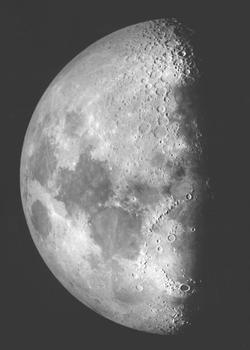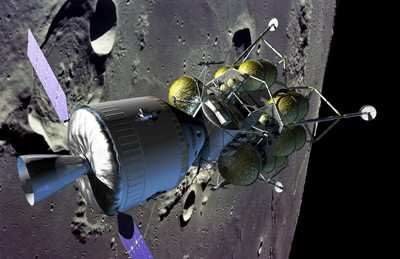Space Agencies Look At Possible Joint Operations On Moon
 Over
the last six months, representatives from NASA and the European
Space Agency, or ESA, have been engaged in a detailed assessment of
potential programs and technologies that when conducted
cooperatively could one day support a human outpost on the
moon.
Over
the last six months, representatives from NASA and the European
Space Agency, or ESA, have been engaged in a detailed assessment of
potential programs and technologies that when conducted
cooperatively could one day support a human outpost on the
moon.
Findings from the study included a significant mutual interest
in the potential development of lunar cargo landing systems,
communication and navigation systems, lunar orbital
infrastructures, and lunar surface systems, such as habitats or
mobility systems. The study also identified the significant value
gained from redundant human crew transportation capability.
"We are very pleased to have worked with ESA on this comparative
architecture assessment," said Geoff Yoder, director of NASA's
Exploration Systems Mission Directorate Integration Office in
Washington. "Since the announcement of the US Space Exploration
Policy, NASA has sought and welcomed input from its international
partners on NASA's lunar architecture plans in areas of mutual
interest. As future exploration plans mature around the world, it
is becoming increasingly important that we seek compatibilities
between NASA's plans and those of its potential future partners.
The work we did with ESA will serve as a model for discussions with
other potential partners as we begin to implement this very
exciting mission."
NASA and ESA experts briefed the results of their Comparative
Architecture Assessment this week during an ESA sponsored
integrated architecture review held at ESA's European Space
Research and Technology Centre in Noordwijk, The Netherlands.
"ESA is preparing itself for a round of decisions that will mark
Europe's role in human spaceflight and exploration for the decades
to come," said Bruno Gardini, manager of ESA's Exploration Program.
"After the satisfaction of the successful deployment of the
Columbus module and Automated Transfer Vehicle, we are looking
forward to enhancing our role in the partnership for a sustained
and robust space exploration program, where human spaceflight is
the cornerstone. The moon is surely an important case study and
useful test bed to thoroughly prepare for more distant
destinations. This architecture work is very useful to prioritize
our proposals to European decision-makers and define a European
strategy."
The study assessed the degree to which NASA and ESA's lunar
exploration architecture concepts could complement, augment, or
enhance the exploration plans of one another. Technical teams from
each agency engaged in a series of joint, qualitative assessments
of the potential scientific and exploration benefits from
collaboration between the ESA capabilities under study and NASA's
space transportation systems and lunar surface exploration
architecture concepts.
NASA is studying lunar surface exploration architecture concepts
to support humans returning to the moon before 2020. Consistent
with the principles of the Global Exploration Strategy -- a
framework for coordinating space exploration plans of 14
participating agencies from around the world -- NASA is pursuing
its lunar exploration plans under an "open architecture" approach.
This approach will maximize opportunities for international and
commercial participation. NASA's architecture concept calls for the
transportation of astronauts and hardware to the moon using the
Ares I and Ares V launch vehicles, the Orion crew exploration
vehicle, and the Altair lunar lander, which are all currently under
development by NASA.

ESA is studying scenarios and associated architectures for human
space exploration, building upon its extensive human space flight
experience, including its contributions to the International Space
Station program. While ESA's studies are currently at a conceptual
stage, some of the scenarios assessed as part of this joint study
included potential future use of an automated, Ariane 5-based lunar
cargo landing system; European developed communication and
navigation systems; and ESA-developed human-rated systems, such as
a crew transportation system and orbital outposts.
 Airbus Racer Helicopter Demonstrator First Flight Part of Clean Sky 2 Initiative
Airbus Racer Helicopter Demonstrator First Flight Part of Clean Sky 2 Initiative Diamond's Electric DA40 Finds Fans at Dübendorf
Diamond's Electric DA40 Finds Fans at Dübendorf ANN's Daily Aero-Term (04.23.24): Line Up And Wait (LUAW)
ANN's Daily Aero-Term (04.23.24): Line Up And Wait (LUAW) NTSB Final Report: Extra Flugzeugbau GMBH EA300/L
NTSB Final Report: Extra Flugzeugbau GMBH EA300/L Classic Aero-TV: 'Never Give Up' - Advice From Two of FedEx's Female Captains
Classic Aero-TV: 'Never Give Up' - Advice From Two of FedEx's Female Captains




